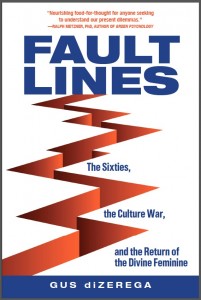 Last month, my new book Faultlines: the Sixties, the Culture War, and the Return of the Divine Feminine was published by Quest. Clicking on the title and linked web page give a pretty good sense of what it discusses, as does a post I just put on PaganSquare. Auspiciously, the date of publication was my birthday, but I was on the road from then until a few days ago, without the peace and quiet to write much. Now that I am back home, I want to focus here at Patheos on the book’s implications for Pagan interfaith relations and why this is very important.
Last month, my new book Faultlines: the Sixties, the Culture War, and the Return of the Divine Feminine was published by Quest. Clicking on the title and linked web page give a pretty good sense of what it discusses, as does a post I just put on PaganSquare. Auspiciously, the date of publication was my birthday, but I was on the road from then until a few days ago, without the peace and quiet to write much. Now that I am back home, I want to focus here at Patheos on the book’s implications for Pagan interfaith relations and why this is very important.
Briefly, I argue we are undergoing a fundamental shift in humanity’s spiritual orientation: from one rooted in agricultural ways of life and focused on the individual and his or her salvation or enlightenment, to one rooted in industry and technology and emphasizing harmony among people and between them and their world. This shift is as deep as the earlier shift from hunting and gathering cultures to agriculture, and its religious impact will be as great.
It was during what many historians now call the “Axial Age” that the earliest of the “modern” great religions began to form. While very different, they shared an all but universal emphasis on the individual’s relationship with the spiritual, the shortcomings of physical life, the separation of humanity from the sacred, and the need to escape this unpleasant reality… And with the rise of exploitive hierarchies, frequent wars, plagues, and famines, reality was often unpleasant for the average person.
The modern transformation
The modern world of cities, technology, material abundance, increased longevity and health, all nurtured by an unprecedented institutionalization of an ethic of equality rather than hierarchy, shifted most people’s experience of life for the better. As life got better in a relatively egalitarian age, images of God as King became unreal; as prosperity eliminated many of the woes of the past, the world became far less a vale of tears and fallen realm; and as spirit came closer to us and infused the world with value, more feminine approaches to spirituality grew in their appeal. Today, spirit increasingly is viewed as everywhere rather than transcendent to us, the world has value beyond its utility to us, and women and feminine values are of growing spiritual importance. These themes exist in most American religious communities outside of the most conservative and right wing.
Most NeoPagans are particularly clear examples of this transformation, but it is happening across a much broader spiritual landscape. Women are a growing percentage of ministers and rabbis. Many mainstream theologians are exploring the feminine dimensions of God. Further, while still being the leader of a tradition that has consistently denigrated women, the Dalai Lama describes himself as a feminist and suggested that the next Dalai Lama might be a woman.
Interfaith work is one more example of this transformational process. For most established religions, engaging in interfaith work is moving into new territory. The interfaith movement teaches devoted practitioners across the world to respect other people’s paths as being as legitimate as their own. Proselytizing is frowned upon. To manage effective interfaith work, religious people have to at least tentatively give up their view that religions stand in hierarchical relation to one another with theirs at the top. As they do so, they discover how Spirit can be found in many different ways. In the process, the idea that Spirit permeates the world becomes increasingly powerful, even without personal experience to that effect. Transcendence need not be abandoned while immanence is embraced.
At a time when a demonic ‘Christian’ religious right increasingly mirrors the worst of Muslim extremists in their policy priorities, if not quite yet their tactics, this is an important counter development.
Not all roses and love
What then about spirituality’s shadow side?
These profound changes threaten those who have most benefited from the old order of hierarchy and domination. I mean here not only human beings, but also spiritual forces feeding off human pride, anger, and fear. I would argue that these are ultimately human-created thought forms, which have waxed sleek and fat on an order rooted in dominating others. If it were human, most people would want the deity the religious right worships locked up with the criminally insane. In its name, the religious right now attacks virtually every transformation in society that arose from the modern democratic world, and no target is more consistently targeted than the feminine and women. This is not, despite their claims, a return to an earlier more ‘Biblical’ time. Since the sacred Feminine and sacred Immanence are attractive alternatives to religious totalitarianism, the religious right must attack them.
These forces can prevail only if they succeed in turning the clock back, because the basic logic of the modern world continually undermines their efforts. A successful society needs educated people and openness to advancement by all with talent, including women. Hence the religious right’s attacks on women’s independence, on science and education, on equality among citizens, and on cities in favor of an imagined rural life that never existed.
At its deepest level, this is the defining struggle of our time, one whose outcome is not guaranteed because those fighting modernity are also fighting every effort to bring the modern world into a sustainable relationship with the earth. If modernity cannot achieve this relationship, it will degrade the conditions needed for its flourishing and fall back into earlier times. If so, the powers of domination and hierarchy will find a world that reliably feeds them the energies they need to prosper.
My book describes this struggle, and documents it from its most recent expression in the Culture War as an attack on “the Sixties,” back to earlier episodes in American history, and describes the ultimate rise of secular and spiritual nihilism as resulting from the collapse of the Christian capital. The tolerant Christian views of men like John Locke gave moral energy to liberalism, but in the eyes of many, the science that liberalism generated wiped out those views’ biblical foundations. If those ethics were a kind of moral social capital, by now they have been largely used up, which is why liberals of all sorts seem so frustratingly passive when attacked by authoritarian nihilism.
This is why Pagans engaging in interfaith work can contribute well beyond our numbers to the spiritual well-being of humanity. A transition to a world emphasizing sacred Immanence and the sacred Feminine holds open the promise of rooting modernity in spiritual traditions that are in harmony with such a society, rather than hostile to it. Ironically, such a shift is also in harmony with what scientists are discovering about the genuinely moral behavior arising within the natural world: that the working out of logic itself in the long run advantages the good guys, and that cooperating in society is by far the most successful evolutionary strategy for success.
But of course, that is what we would expect of Spirit if it were immanent.















